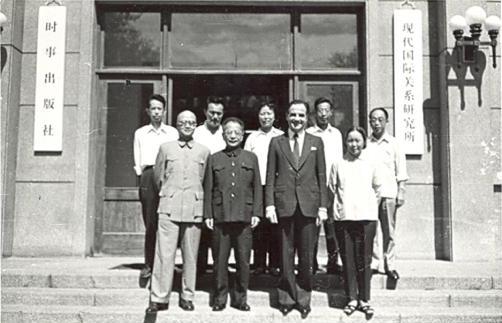Above a picture of prof. Chen Zhongjing with prof. Giancarlo Elia Valori, Honorary Chair at the University of Beijing While in Italy we a
Above a picture of prof. Chen Zhongjing with prof. Giancarlo Elia Valori, Honorary Chair at the University of Beijing
While in Italy we are struggling to follow the orders of the United States of America, whether it has a good, bad or sleeping President, the Iranian economy is developing and (as we will see later) some European countries are getting tired of following the instructions from across the Atlantic which, under the pretext of human rights, have created and imposed the sanctions that first of all damage Western economies, which are then forced to turn to the West at higher prices, or be reimbursed by the States themselves, i.e. at the expense of their citizens. But let us look at the fast developing Iranian economy.
In 2021, the Islamic Republic of Iran had a 59.1% trade-to-GDP ratio and merchandise trade accounted for 88.2 per cent of total trade. From 2017 to 2021 Iran’s merchandise exports decreased by 0.3 per cent and merchandise imports increased by 2.7 per cent nominally each year on average.
Merchandise exports grew slower than the Asia-Pacific region’s annual growth of 9.6 per cent during the same period. Similarly, Iran’s merchandise imports lagged behind the Asia-Pacific region’s annual growth of 10.1 per cent.
In 2021, Iran’s merchandise exports increased by 52.7 per cent and imports grew by a nominal 26.4 per cent. Looking ahead, Iran’s merchandise exports are expected to grow by 10.2 per cent in 2022 and by a more modest 1.9 per cent in 2023.
On the import side, Iran is expected to grow by 12.4 per cent in 2022 and by 10 per cent in 2023, while the Asia-Pacific region is expected to grow by 13 per cent in 2022 and by a more moderate 2.5 per cent in 2023. The share of service trade in Iran’s total trade was equal to 11.8 per cent in 2021. Over the 2017-2021 period, Iran’s exports of commercial services decreased by 9 per cent annually and imports of commercial services decreased by a 6.6% yearly average in nominal terms, lower than the average growth of 3.7% and 1.7% in the Asia-Pacific region, respectively.
In 2021, Iran’s service exports grew by 20.9 per cent, following a 56.4% year-on-year fall in 2020. Exports in the Asia-Pacific region grew by 18.8 per cent in 2021, after decreasing by 21.4 per cent in 2020. Iran’s imports of commercial services recovered by 52.3 per cent in 2021, compared to a 15.2% growth in the Asia-Pacific region.
Sector-wise, “travel services” accounted for 40.3 per cent of Iran’s total trade in business services in 2021, followed by “transport services” at 34.9 per cent and “other business services” at 7.7 per cent. The main support for Iran’s service export growth in the 2017-2021 period was “ICT services”. ICT stands for Information and Communications Technology and refers to all processes and practices related to transmitting, receiving and processing data and information.
On the import side, “transport services” contributed the most to the growth of trade services, increasing by a 5.6% yearly average over the same period. Looking ahead, Iran’s service exports are expected to increase by 15 per cent in 2022 and by 10 per cent in 2023.
Comparatively, exports to the Asia-Pacific region are expected to grow by 8.9 per cent in 2022 and by 8 per cent in 2023. Meanwhile, by comparison, Iran’s imports of services are expected to increase by 20.7 per cent in 2022 and by 10.1 per cent in 2023. Exports are expected to increase by 10.5 per cent in 2022 and by 4.5 per cent in 2023.
In 2021 Iran’s main merchandise trading partner was the People’s Republic of China, accounting for 44.6 per cent of its exports and 28.9 per cent of its imports. 2.5 per cent of Iran’s exports and 23 per cent of Iran’s imports by value were traded with the United Arab Emirates, its second largest trading partner. Other important trading partners were Turkey, Brazil, Germany, India, Italy, Ukraine (before the conflict), Oman and Pakistan. The largest category of products exported by Iran in 2021 was “ethylene polymers, in primary forms”, with a 23.7% export share of total exports, followed by the second largest category, namely “nuts” (excluding coconuts, Brazil nuts and cashews) – fresh or dried, including shelled or peeled ones – which accounted for 6.4 per cent of Iran’s total exports.
In terms of imports, telephones – including telephones for mobile or other wireless networks – as well as other devices for transmitting or receiving voice, images or other data (including wired/wireless networks), accounted for 13.8 per cent of total imports, standing out as the first category of imported products.
Meanwhile, maize (corn) had a 5.3% share and was the second largest imported product. Iran is currently not a WTO member (but an observer) and therefore no notified detailed tariff information is available.
From 2017 to 2021 Iran recorded an 11.5% average annual decrease in IDE inflows (Integrated Design Environment or Integrated Debugging Environment, i.e. a software that, in the programming phase, supports programmers in developing and debugging source codes, i.e. in searching for and correcting errors in the operation of a system or programme), which was lower than the 3.8% average annual growth in IDE inflows recorded in the Asia-Pacific region.
In 2021 Iran recorded a 6.2% increase in IDE inflows. It recorded a 4.3% average annual decline in IDE outflows over the past five years, which was also lower than the 3.2% average annual growth in IDE outflows recorded in the Asia-Pacific region.
In 2021 Iran recorded a 4.1% increase in IDE outflows. Iran’s trade costs with the large developing economies of China, India, Indonesia and the Russian Federation were the lowest.
In 2018 trade costs with large Asia-Pacific developing economies averaged 103.4 per cent of the value of goods, compared to the time and situation in which countries trade these goods within their borders.
Trade costs with the economies of China, Japan and the Republic of Korea, as well as with Germany, France and the UK, were the highest, at 132.6 per cent and 155.4 per cent, respectively. Since 2018 Iran has ranked in the 63rd percentile for logistics services among the other countries in the Asia-Pacific region.
Iran had seven trade agreements in force, no signed agreements pending ratification, and two trade agreements under negotiation as of 2021. A 43.5% share of the country’s total exports for the year went to its trading partners, while 52.4 per cent of its total imports came from trade agreement partners.
As mentioned above, the sanctions and unilateral restrictions imposed by some Western countries on Iran have damaged the Western economy because they have isolated these companies from the Iranian market, and many people are complaining, especially in Spain.
Since the imposition of sanctions, Iran has found alternative options to Western companies. It buys goods from other countries, but the economic crisis in European countries has led to a situation in which European companies will be dissatisfied with the political decisions made by some other-directed European governments.
Spain considers itself a victim of the sanctions imposed on Iran by its Atlantic allies and, therefore, Spanish companies are trying to find ways to develop relations with Iran. Indeed, if we actually look at the nature of these sanctions, we realise that they have caused more damage to Western countries than they have caused Spain, in particular, to lose the large Iranian market. Spanish companies doing business in Iran have repeatedly criticised their government for implementing sanctions. If in Italy there is any company that complains about such situation, silence falls and nobody talks about it.
European countries – as it is ridiculous to use the word “Europe” as expression of a single will – have a desire to prevent their companies from being subjected to sanctions imposed by the United States for bilateral spite that is rooted in modern history. The main problem is the possibility of implementing US sanctions extraterritorially, as well as the possibility that, besides Iranian companies, the European companies that are already working with Iran may – in turn – become the target of US sanctions pressure.
If Europe succeeds in defending its own interests, it should ensure that US sanctions against Iran do not affect European companies. Moreover, if the Europeans succeed in defending their own real independence, a precedent will be set when the fate of sanctions is decided without reference to single-State policy and third-country legislation.
European countries are clearly under economic pressure and the USA has not only refused to conclude the Transatlantic Trade and Investment Partnership (TTIP), but also intends to set quotas for steel and aluminium imports from the EU. Furthermore, the compensatory measures provided by EU governments to the companies that may be subject to US secondary sanctions do not fully compensate for the costs, besides weighing on the European citizens’ shoulders.
Giancarlo Elia Valori


